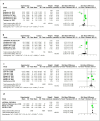Imaging-validated correlates and implications of the pathophysiologic mechanisms of ageing-related cerebral large artery and small vessel diseases: a systematic review and meta-analysis
- PMID: 40264233
- PMCID: PMC12016073
- DOI: 10.1186/s12993-025-00274-1
Imaging-validated correlates and implications of the pathophysiologic mechanisms of ageing-related cerebral large artery and small vessel diseases: a systematic review and meta-analysis
Abstract
Background: Cerebral large artery and small vessel diseases are considered substrates of neurological disorders. We explored how the mechanisms of neurovascular uncoupling, dysfunctional blood-brain-barrier (BBB), compromised glymphatic pathway, and impaired cerebrovascular reactivity (CVR) and autoregulation, identified through diverse neuroimaging techniques, impact cerebral large artery and small vessel diseases.
Methods: Studies (1990-2024) that reported on neuroradiological findings on ageing-related cerebral large artery and small vessel diseases were reviewed. Fifty-two studies involving 23,693 participants explored the disease mechanisms, 9 studies (sample size = 3,729) of which compared metrics of cerebrovascular functions (CF) between participants with cerebral large artery and small vessel diseases (target group) and controls with no vascular disease. Measures of CF included CVR, cerebral blood flow (CBF), blood pressure and arterial stiffness.
Results: The findings from 9 studies (sample size = 3,729, mean age = 60.2 ± 11.5 years), revealed negative effect sizes of CVR [SMD = - 1.86 (95% CI - 2.80, - 0.92)] and CBF [SMD = - 2.26 (95% CI - 4.16, - 0.35)], respectively indicating a reduction in cerebrovascular functions in the target group compared to their controls. Conversely, there were significant increases in the measures of blood pressure [SMD = 0.32 (95% CI 0.18, 0.46)] and arterial stiffness [SMD = 0.87 (95% CI 0.77, 0.98)], which signified poor cerebrovascular functions in the target group. In the combined model the overall average effect size was negative [SMD = - 0.81 (95% CI - 1.53 to - 0.08), p < 0.001]. Comparatively, this suggests that the negative impacts of CVR and CBF reductions significantly outweighed the effects of blood pressure and arterial stiffness, thereby predominantly shaping the overall model. Against their controls, trends of reduction in CF were observed exclusively among participants with cerebral large artery disease (SMD = - 2.09 [95% CI: - 3.57, - 0.62]), as well as those with small vessel diseases (SMD = - 0.85 [95% CI - 1.34, - 0.36]). We further delineated the underlying mechanisms and discussed their interconnectedness with cognitive impairments.
Conclusion: In a vicious cycle, dysfunctional mechanisms in the glymphatic system, neurovascular unit, BBB, autoregulation, and reactivity play distinct roles that contribute to reduced CF and cognitive risk among individuals with cerebral large artery and/or small vessel diseases. Reduction in CVR and CBF points to reductions in CF, which is associated with increased risk of cognitive impairment among ageing populations ≥ 60 years.
Keywords: Ageing; Cerebral small vessel disease; Cognitive; Large artery disease; Neuroimaging; Pathophysiology.
© 2025. The Author(s).
Conflict of interest statement
Declarations. Competing interests: The authors declare no competing interests.
Figures






Similar articles
-
Clinical implication and prognosis of normal baseline cerebral blood flow with impaired vascular reserve in patients with major cerebral artery occlusive disease.Ann Nucl Med. 2010 Jun;24(5):371-7. doi: 10.1007/s12149-010-0367-9. Epub 2010 Mar 18. Ann Nucl Med. 2010. PMID: 20238185 Clinical Trial.
-
Associations of Cerebrovascular Regulation and Arterial Stiffness With Cerebral Small Vessel Disease: A Systematic Review and Meta-Analysis.J Am Heart Assoc. 2023 Dec 5;12(23):e032616. doi: 10.1161/JAHA.123.032616. Epub 2023 Nov 28. J Am Heart Assoc. 2023. PMID: 37930079 Free PMC article.
-
Higher Aortic Stiffness Is Related to Lower Cerebral Blood Flow and Preserved Cerebrovascular Reactivity in Older Adults.Circulation. 2018 Oct 30;138(18):1951-1962. doi: 10.1161/CIRCULATIONAHA.118.032410. Circulation. 2018. PMID: 30018169 Free PMC article.
-
Effect of menopause on cerebral artery blood flow velocity and cerebrovascular reactivity: Systematic review and meta-analysis.Maturitas. 2021 Jun;148:24-32. doi: 10.1016/j.maturitas.2021.04.004. Epub 2021 Apr 19. Maturitas. 2021. PMID: 34024348
-
Cerebrovascular Effects of Sildenafil in Small Vessel Disease: The OxHARP Trial.Circ Res. 2024 Jul 5;135(2):320-331. doi: 10.1161/CIRCRESAHA.124.324327. Epub 2024 Jun 4. Circ Res. 2024. PMID: 38832504 Free PMC article. Clinical Trial.
References
-
- Li H, Cao W, Zhang X, et al. BOLD-fMRI reveals the association between renal oxygenation and functional connectivity in the aging brain. Neuroimage. 2018;2019(186):510–7. 10.1016/j.neuroimage.2018.11.030. - PubMed
Publication types
MeSH terms
LinkOut - more resources
Full Text Sources
Medical

